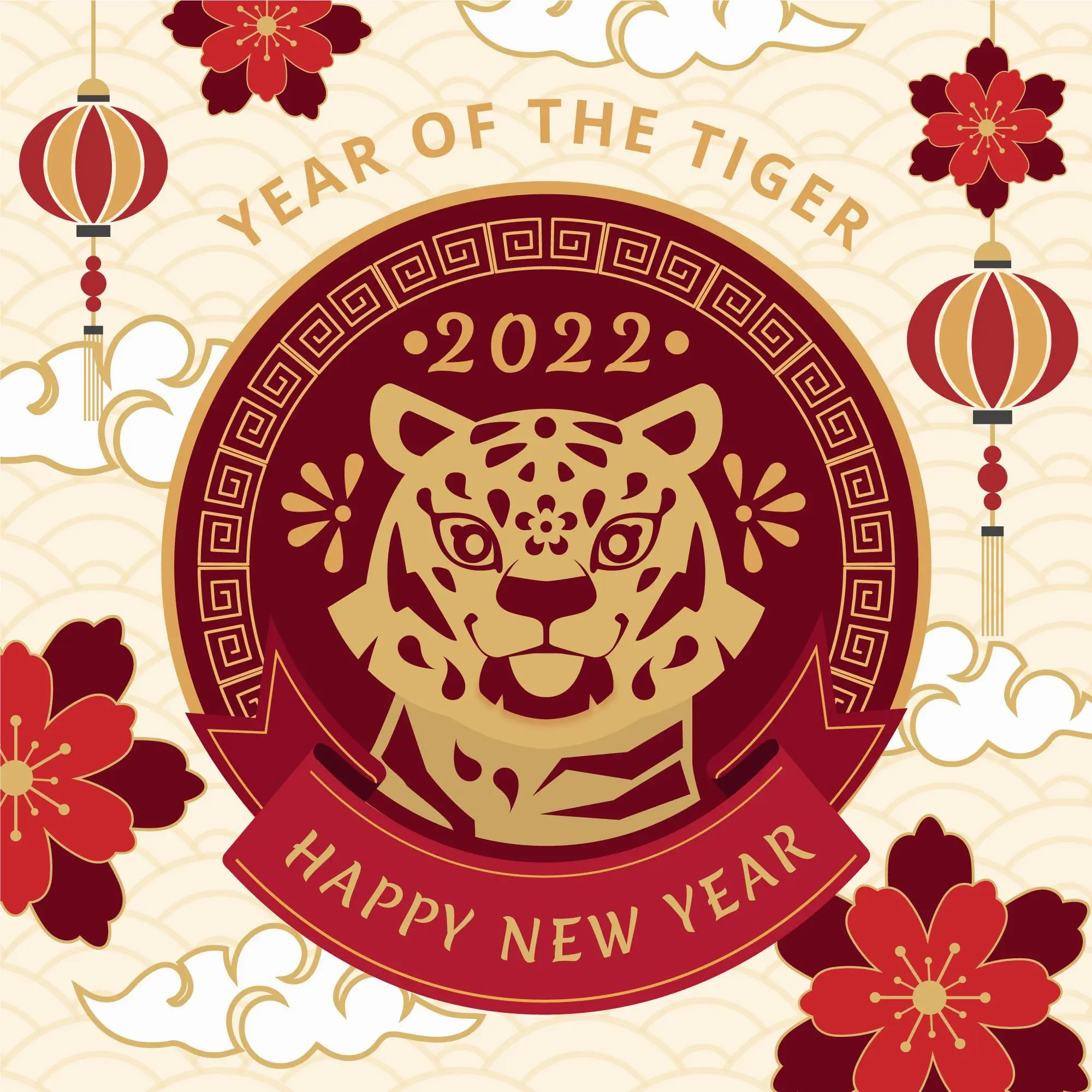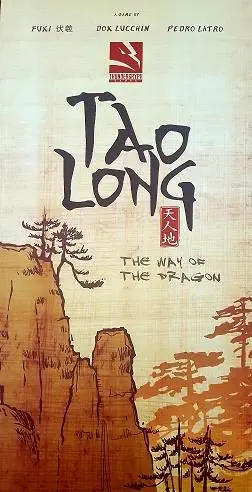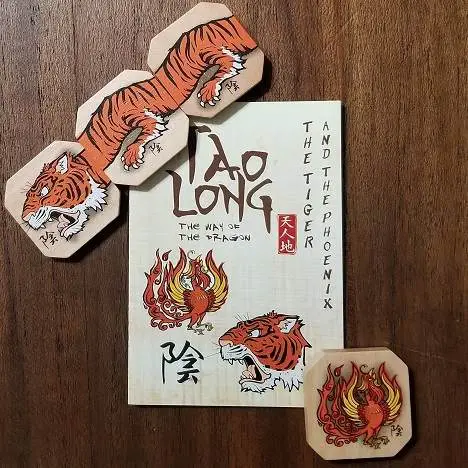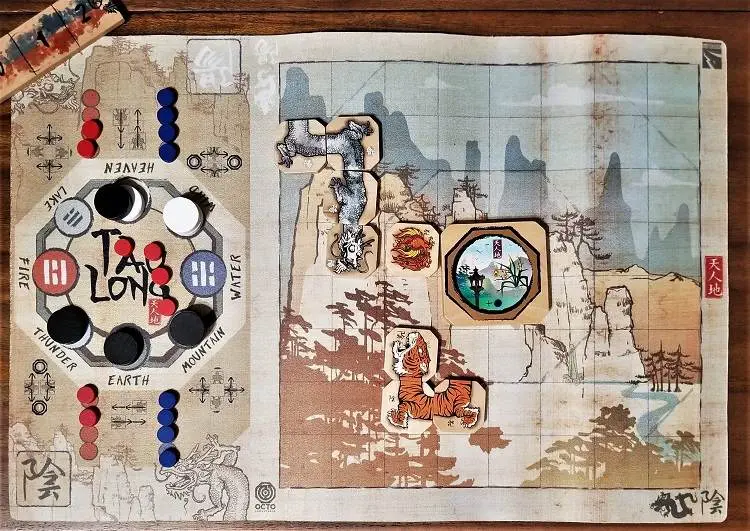
As we say goodbye this week to the Ox and its promises of hard work, peacemaking, and fortune for 2021, the Tiger is about to begin its year-long reign. As a Tiger year, 2022 brings with it assurances of strength, prosperity, and big changes; whatever they may be. To celebrate this transition of the lunisolar calendar, we here at the Cantina are celebrating with our usual tradition of homemade food, gifting of Hongbao to friends and family, and, of course, a game night. This year, we are bringing Tao Long: The Way of the Dragon back to the table with its Tiger & Phoenix expansion in honor of this year’s zodiac animal.

Though it has been several years since we originally reviewed Tao Long, it is a game that has continued to find its way back to the table time and again. Kickstarted in 2017 by Thundergryph Games and Octo Ludustudio, Tao Long is a two-player board game featuring two dragons (Heaven/yang and Earth/yin) and their conflicts to determine which forces will predominantly influence humanity for the next era. It was designed by Pedro Latro and Dox Lucchin, who also provided the art. Within the base game, there are numerous game modes and scenarios for beginners and advanced players alike as well as multiple micro expansions available for purchase. However, one of the things I really love about the game design is that it not only provides a lot of variety with setup and game play but also encourages players to create their own scenarios and allows them to mix and match components as desired. For this particular review, we are using the Tiger & Phoenix expansion as well as the Spring components from the Four Seasons expansion to signify the current transitions being celebrated during the fifteen-day Spring Festival.

In both Chinese legend and philosophy, the image of tigers and dragons as opposing forces is quite common. Tigers, though smaller in stature, are shown to be fierce, bold, and seem to bulldoze through their opponents in contrast to the patient, laid-back, wise dragon. The Tiger & Phoenix expansion for Tao Long not only pits these two ancient foes against one another but adds another legendary creature to the mix: the Phoenix. These two yin creatures work together against the yang Heaven Dragon in an attempt to bring about an “era of introspection and inner peace” for humanity. With the inclusion of this expansion, not much changes for the game setup, but some prominent differences will be noticed as the game progresses. Instead of using the Earth Dragon, the smaller, 3-segmented Tiger is used and will begin the game in the same positioning. The Phoenix will sit close by, waiting for its opportunity to come into play. Once the Yin player has gained fire stones from the Ba Gua, the firey companion is placed adjacent to the head of the Tiger, facing in any direction of the player’s choosing. When there are no more fire stones in that player’s possession, the Phoenix’s light has gone out and it is removed from play until there are, once again, stones to resurrect it from the ashes. While in play, the Phoenix will act simultaneously, though separately, with the Tiger in each phase of the game. The Tiger may only make water attacks, the Phoenix may only utilize fire and, should either receive damage, stones are removed from their correlating element. Otherwise, all rules are the same, but these changes will take a bit of getting used to and we recommend playing at least a few games to fully realize the potential of the new duo.
To ensure the focus of our review remains on the Tiger & Phoenix expansion, we chose to utilize a simple scenario while still showcasing some of the elements of the Seasons expansion; specifically the use of the Spring tile. In our game, Spring is finally coming to a small village located in a large, open field. As the healing energies of the new year begin to fill the air, the sounds of battle can be heard as they are carried to the villagers on a gentle breeze. Overhead, a keen eye would see the spirits in conflict and the villagers are prepared to aid their chosen patron should the skirmish wind up too near their beloved homes. To portray these events, we have chosen The Field scenario from the book and added the Spring tile to act as the Village being protected by the Tiger player. When using the Seasons expansion, Spring causes players to replace one missing water stone at the beginning of their turn to represent new life and prosperity as the season proceeds to influence the energies of the new year. The culmination of these choices created a custom scenario that we felt would be both engaging and representative of this Lunar New Year’s transitional aspects.

The scenario had been created, the board was set up, and the fortune cookies were laid out. Right out of the gate we noticed that the Tiger player was going to have to rethink the mechanics of the game. Bringing out the Phoenix too early would create a navigational nightmare even with the fairly open board, yet waiting too long would allow the Dragon’s navigator to block optimal choices during the game. The village presented its own threat to the Dragon in that, even though they were at an advantage for life total, they were pressed to keep to the board’s edge and take the long route to engage their opponent. Our first play found the Tiger poorly positioned, even with its advantages, to stand against the Dragon with the Phoenix doing little to assist in the conflict. Another attempt found the Dragon falling fairly quickly as the Tiger focused more on controlling the board rather than pure aggression. All in all, we played three games, switching sides for the last, and found the expansion to be quite different than the base game and a lot of fun.
This expansion may seem small in regards to the components included, but it is deceptively quite the game-changer. The altered tactical choices it places on both players, to either pilot the new creatures or find ways to deal with the double threat, will quickly bring themselves to light as an interesting and challenging new way to, metaphorical to the phoenix, bring new life to the game. Though we have more experience with the game than we did during our previous review, we still highly recommend playing a few learning rounds when adding in new mechanics such as these. The premise of the game may not change, but the strategy certainly does! Years later and we still feel that Tao Long is easy to learn the concepts for, but hard to master. Adding the expansions certainly makes practicing more fun, though! May the Year of the Tiger bring you luck, longevity, and prosperity! Gong Xi Fa Cai!
All photos of Thundergryph Games products were taken and edited by Krista.